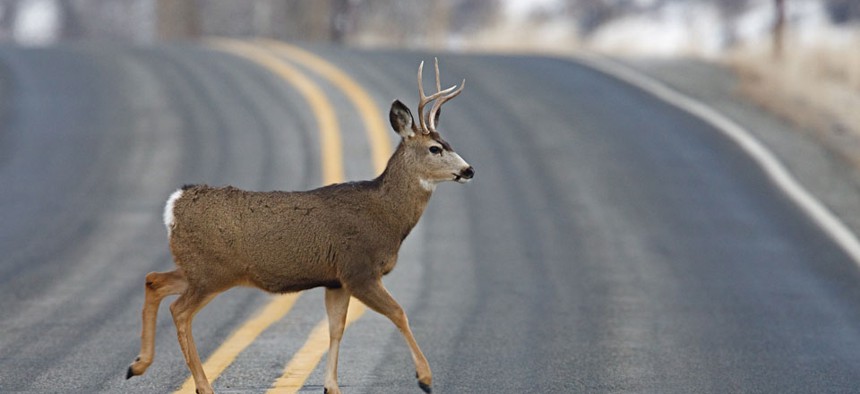It's Deer-Collision Season

Tom Reichner/Shutterstock.com

Connecting state and local government leaders
Deer collisions rise precipitously in autumn—so watch out, West Virginia, Iowa, and Pennsylvania.
Night drivers, keep your eyes peeled: Deer-collision season is upon us. According to the Highway Loss Data Institute ( HLDI ), an insurance industry group, deer-collision rates as measured by insurance claims filed follow a familiar annual pattern—rising dramatically in October, peaking in November, and going strong through December before bottoming out in August.

As measured per 1,000 insured vehicle years (HLDI)
Why the autumn jump in collisions? Deer migration and mating season runs from October to December, meaning more frenzied deer roam more widely in these months than any others.
An HLDI study found that there were 6.5 animal strikes—mostly caused by deer—per 1,000 insured vehicle years between 2006 and 2011. ("Insured vehicle years" is a technical industry measure: One "year" is one vehicle insured for one year, two vehicles for six months, or three vehicles for four months, etc.) That makes for something close to 1.3 million deer-vehicle collisions in the U.S. each year, leading to 150 annual deaths and tens of thousands of injuries.
HLDI also found that deer strikes are becoming more severe. The group's study found that while claim severity followed the same seasonal patterns as the overall animal-strike rate, claims got more expensive—and accidents probably more severe—between 2006 and 2011. In 2006, claims averaged out to $2,697. By 2011, they were a full nine percent higher at $2,898.

(HLDI)
This leap in severity is, no doubt, related to the country’s exploding deer population. In the early 1900’s, Cornell University researchers report , there were 500,000 white-tailed deer in the U.S.; by the turn of the century, there were 20 million. Those rising numbers have to do with a number of dramatic environmental changes: the rapid elimination of large predators like wolves and mountain lions, for whom deer are natural prey; population shifts to rural and suburban areas after World War II; and new limitations on hunting, which allowed the deer population to balloon.
In recent years, however, the growth of animal strikes has been stymied by the Great Recession, of all things. Higher gas prices and a weak economy means fewer people are on the road. And fewer cars means fewer crashes overall.
Deer collision season is worst in West Virginia, Iowa, and Pennsylvania, HLDI found. Those states have particularly ugly Novembers, with averages of 51.2, 30.6 and 28.9 claims per 1,000 insured vehicle years in that month. For comparison, HLDI pinned the national rate at 14.4.
Meanwhile, relatively deer-sparse states like California, Hawaii, New Mexico, and Florida had less than five claims per 1,000 insured vehicle years in November during the HLDI study period.

(HLDI)
Says this Mid-Atlantic resident: Well , at least we don’t have alligators.
( Top image via Tom Reichner / Shutterstock.com )




